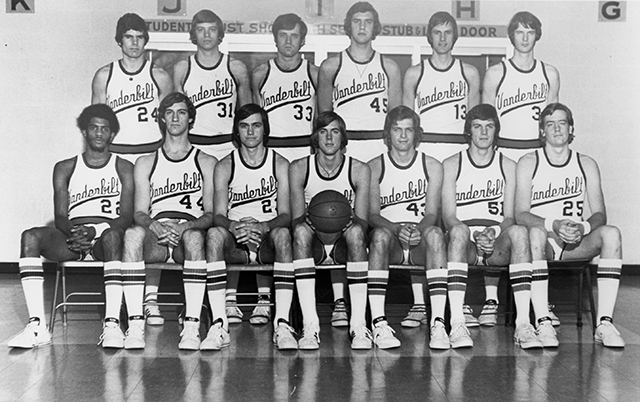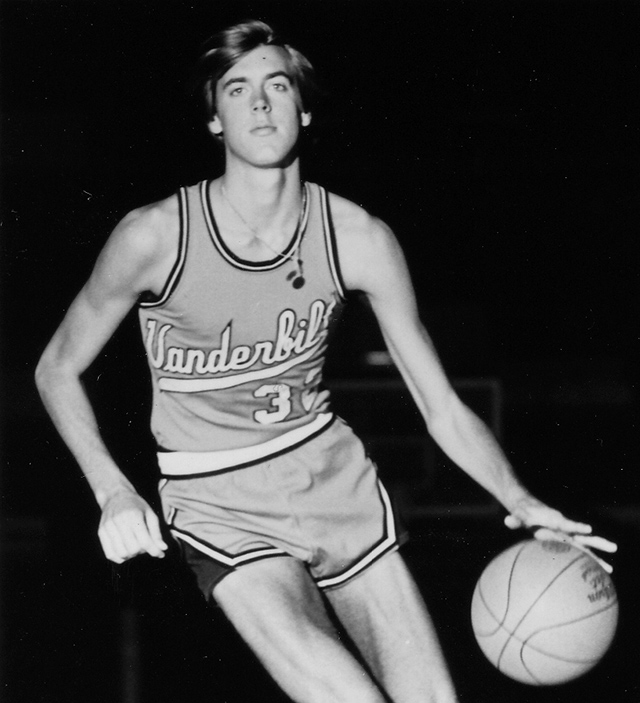Jan. 20, 2016

Commodore History Corner Archive
Former Vanderbilt basketball assistant coach Ron Bargatze said that the February 11, 1974 game with LSU was the “most electric atmosphere” he had ever experienced at Memorial Gymnasium.
One month earlier in the first meeting in Baton Rouge there was a fight with 1:08 left in the game when Commodore center Jan van Breda Kolff was pushed by the Tigers’ Wade Evans after trying to draw a charge. Collis Temple, who fouled out earlier, sprinted off the LSU bench and kicked van Breda Kolff in the back. A melee ensued. Temple, van Breda Kolff and Evans were ejected from the game. Van Breda Kolff suffered a partially collapsed lung during the scuffle. LSU won the game, 84-81.
The loss was the first of the season for coach Roy Skinner’s No. 6 ranked club as Vanderbilt left Baton Rouge with a 10-1 record, but on its way to an SEC co-championship. The Commodores reeled off eight straight wins since that defeat as they entered the home rematch with coach Dale Brown’s LSU squad. Vanderbilt, with its 18-1 (10-1 SEC) record, was ranked No. 5 in the country entering the game.
John Bibb of the Tennessean wrote on the morning of the game:
“It’s been a month now since LSU beat Vanderbilt in the well-chronicled Battle of Baton Rouge. It strikes me – and that’s a poor verb selection – that just about enough has been written and said concerning the details of the furious finish on the night of January 12. Subsequent to LSU’s 84-81 victory, more than average coverage was afforded the more than average story of arrest, investigation, reprimand and probation that resulted from the basketball court incident.
“Nevertheless, how about one final thought that somehow seems worth presenting on this particular day, the morning of tonight’s heralded rematch between the Southeastern Conference rivals at Vandy’s Memorial Gymnasium?”
“It is true there was quite a stir made about Coach Skinner’s totally uncharacteristic failure to shake hands with LSU’s coach Dale Brown after the game at Baton Rouge. It was, indeed, an unusual bit of business.
“But, lest we forget, some people on the floor that night did shake hands. They were players. They were Wade Evans and Bill Ligon. As a matter of fact, Ligon and Evans – combatants in one of the several physical exchanges, which erupted – did more than shake hands. In their moment of offering condolences and congratulations after the game, Ligon and Evans had their arms about each other in what coach Brown described as evidence of an ‘embrace of friendship and respect.’
“Tonight, when the teams meet again, it is no secret that the eyes of all the SEC will be centered on Nashville. Because of Vanderbilt’s position in the national ratings, it is quite probable that millions of college basketball fans will be watching to see what happens here in this rematch.
“Without exception, every observer knows the burden of example rests with the Commodores and their in-person fans, all 15, 581 of them. From coast to coast, Vandy’s 1973-74 basketball team has been tagged as a ‘class outfit,’ maybe the most cherished commendation any athlete in any sport may achieve.”
Vanderbilt did win the rematch 91-88, but not without controversy. Vanderbilt students arrived two hours before tip-off most wearing T-shirts that were not so kind to LSU. When LSU took the floor for pregame warmups, the Vanderbilt student section chanted, “block that kick, block that kick” in reference to Temple who kicked van Breda Kolff and was reprimanded by SEC Commissioner Boyd McWhortor for his part in the earlier game.
With the score knotted at 48 at halftime, Brown was informed that there was a telephone call threat against the life of Temple if he played in the second half. Temple recorded 10 points by intermission. A dozen uniformed policemen and campus security met Brown at the LSU dressing room.
Brown did not tell Temple of the threat on his life, but said about his players “who knew something funny was up when I wouldn’t let them go back onto the floor at halftime, that some drunk had called and said he was going to shoot me. I said we would just wait a couple of minutes before going out.”
The threat came to the Vanderbilt operator while the game was in progress. When the Tigers returned to the floor to warmup, Brown met with Skinner and the two game officials at the scorer’s table. The crowd sensed that something unusual was occurring, but were unaware of the topic of discussion until after the game.
Said Brown after the game, “I merely told the officials, Coach Skinner and the men at the scorer’s table that I would take the LSU team off the floor immediately if there was any type of disturbance. In this connection, I want to be very clear in praising Vanderbilt security, the local police and the state police for their courtesies here in Nashville.
“Vanderbilt administered this game in a very explosive situation, extremely well, just as I have said LSU administered the game in Baton Rouge very well. The Vanderbilt students were not that bad. I thought, as a matter of fact, that they were quite fair. They had their fun, but the harassment of Collis Temple came from the adults in the crowd.”

Vanderbilt’s victory came at the foul line where they scored their final eight points to fight off a desperate LSU comeback. The Commodores had six players to score in double figures: van Breda Kolff (16), Lee Fowler (15), Joe Ford (14), Butch Feher (13), Jeff Fosnes (12), Ligon (12) and Terry Compton (9). LSU’s top scorers were Glenn Hanson (35) and Eddie Palubinskas (27). Temple hit one field goal in the second half to total 12 points. The Tigers finished the season 12-14 (6-12 SEC).
“In that particular season both games against Alabama were highly contested,” Bargatze said in recent years. “Alabama was the second best team in the conference. In the return game at Memorial Gym, there was way, way more policeman at any game than I had seen before. The return match attracted arguably the largest crowd that had ever been in the gym.
“I think there was no question there was 16,000 people there. They were lined up against the walls, and sitting in the aisles. I don’t know if there were any fire marshal instructions there, but there should have been. Certainly we were well over capacity.
“It was a carnival atmosphere. Kentucky, Tennessee and Alabama were always big games and very well attended. All the stuff in the first game really created huge attention on the return match. There was a death threat that only a few of us knew. The excitement, the electricity at Memorial Gym had never been better including the Kentucky and Tennessee games over the years. I had never seen a game that had more hoopla around it with as much anticipation than that one.”
After the game, Skinner did not want to comment on the evening’s events, but said the crowd “was one of our very best. The fans were behind us all the way and it was a tough one again for us to win.” The game ended without any disruptions on the court.
Vanderbilt (23-5) finished the season as SEC co-champions with Alabama and identical 15-3 conference records. The Commodores represented the league in the NCAA National Tournament by beating the Tide twice during the regular season.
The Commodores lost to Marquette (69-61) in the Mideast Regionals and to Notre Dame (118-88) in the consolation game. The Commodores were ranked No. 13 in the final Associated Press rankings. Van Breda Kolff was named the SEC Player of the Year and an All-American.
Traughber’s Tidbit: Vanderbilt’s first basketball schedule was in 1900-01 and except for two seasons, 1904-05 and 1905-06, Vanderbilt has played basketball every year since. For those two vacant seasons basketball was not played due to the university cutting basketball from athletic competition. The reason given was that practicing basketball in the campus’ Old Gym was taking up too much time, which cut down on the gymnastic activities.
Therefore no other on campus facility for basketball practices existed. It was also in 1904 that Dan McGugin was in his first season as the Commodores head football coach. McGugin led his squad to a 9-0-0 year. There is no evidence that McGugin was involved in the decision to shut down Vanderbilt basketball at that time. A group of students pushed the Athletic Association for basketball to return, which it did (1906-07) after the two-year absence.
Tidbit Two: Vanderbilt traveled on its first out of town road trip by train to Birmingham in February 1902. The first opponent was Howard College whose gym was an old store warehouse “fitted with baskets the opponents had nailed so close to the ceiling that a ball tossed with any arc would strike the ceiling first and fall into hands of rebounders.” Of course the Howard players knew this and bounced the ball “gently” off the rafters as they had practiced all winter. By the time Vanderbilt realized this and adjusted their shots they were down by a large margin and lost the game, 33-23. (Source: “Dynamite, 75 Years of Vanderbilt Basketball” by Roy M. Neel in 1975)
If you have any comments or suggestions contact Bill Traughber via email WLTraughber@aol.com.



